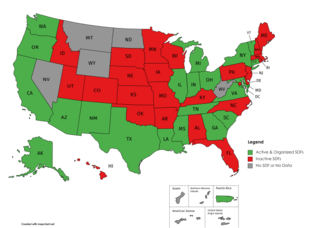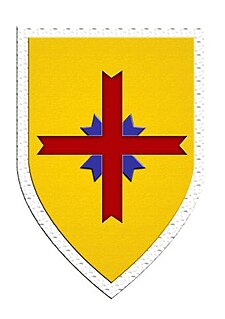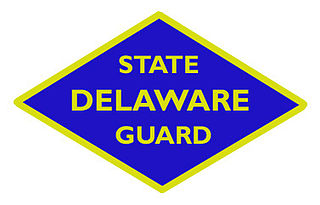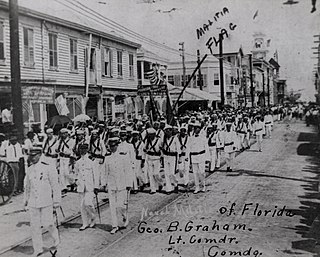
In the United States, state defense forces are military units that operate under the sole authority of a state government. State defense forces are authorized by state and federal law and are under the command of the governor of each state.

The Ohio Military Reserve (OHMR) is a military force which supports the State of Ohio along with the Ohio Army National Guard and Ohio Air National Guard in times of natural disaster and state and national emergencies.

Auxiliaries are support personnel that assist the military or police but are organised differently from regular forces. Auxiliary may be military volunteers undertaking support functions or performing certain duties such as garrison troops, usually on a part-time basis. Unlike a military reserve force, an auxiliary force does not necessarily have the same degree of training or ranking structure as regular soldiers, and may or may not be integrated into a fighting force. Some auxiliaries however are militias composed of former active duty military personnel and actually have better training and combat experience than their regular counterparts.

The Georgia State Defense Force is an unpaid, volunteer component of the Georgia Department of Defense, serving in support of the national and state constitutions under direction of the governor and the adjutant general of Georgia. As a State Defense Force, members serve alongside the Georgia Army National Guard and the Georgia Air National Guard.

The Washington Air National Guard is the aerial militia of the State of Washington, United States of America. It is, along with the Washington Army National Guard, an element of the Washington National Guard.

The Puerto Rico State Guard (PRSG) —Spanish: Guardia Estatal de Puerto Rico— is the state defense force of Puerto Rico that operates under the sole authority of the governor of Puerto Rico who, in turn, delegates such authority to the Puerto Rico Adjutant General. The Guard's secondary purpose is to assume the state mission of the Puerto Rico National Guard in the event that the National Guard is mobilized. The first incarnation of the PRSG was created in 1941 in response to World War II and it disbanded in 1946. The PRSG is one of the few state defense forces of the United States that has an air division.

The Washington State Guard is the state defense force of the U.S. state of Washington. It is the third element of the state's military forces which also include the Washington Army National Guard and the Washington Air National Guard.

The Tennessee State Guard (TNSG) is the state defense force of the state of Tennessee. The TNSG is organized as an all-volunteer military reserve force whose members drill once per month unless called to active duty. The TNSG is a branch of the Tennessee Military Department, alongside the Tennessee Army National Guard, the Tennessee Air National Guard, and the Tennessee Emergency Management Agency. The State Guard acts as a force multiplier for the state's National Guard. As a state defense force, the Tennessee State Guard cannot be federalized, and is not deployed outside the borders of Tennessee, as it is a purely state-level unit. It answers solely to the Governor of Tennessee, unlike the dual federal and state controlled National Guard. The creation of a state military force is recognized under Tennessee Code Annotated 58-1-401.

The Vermont State Guard (VSG) is the all-volunteer state defense force of the state of Vermont. The Vermont State Guard serves parallel to the Vermont National Guard, acting as a reserve force for the State of Vermont Military Department. The Vermont State Guard is a reserve force composed of individuals living as civilians when not activated, but the force can be activated in the event of an attack or natural disaster to serve as a force multiplier for the National Guard, and is assigned to fulfill the state mission of the National Guard when the National Guard is deployed.

The Delaware State Guard is the currently inactive state defense force of the state of Delaware, which was active during both World War I and World War II. As the official militia of the state, the Delaware State Guard was created with the intent of acting as a stateside replacement for the Delaware National Guard while the National Guard units were deployed abroad.

The Pennsylvania State Guard is the currently inactive official state defense force of the state of Pennsylvania, which was active during World War II and the Korean War. The unit was organized as a home guard composed of volunteers who were trained and organized as parallel to the state’s National Guard. As a part of Pennsylvania's official militia, the Pennsylvania State Guard was trained, organized, and funded by the state of Pennsylvania, answered to the governor, and could not be federalized or deployed abroad.

The Florida Naval Militia was the official naval militia of the state of Florida. Naval militias were organized as naval parallels to the National Guard as dual federal and state obligations, with the naval militias normally being under state control but subject to federal activation. The Florida Naval Militia was active during three periods in Florida history: between 1897 and 1903; between 1911 and 1917; and between 1934 and 1941.
The Hawaii Territorial Guard was the state defense force of Hawaii during World War II. As a result of the National Guard of Hawaii being federalized for the duration of the war, the Hawaii Territorial Guard was created to serve as the stateside replacement for the National Guard. During the war, it was the sole military force available to the Governor of Hawaii as its captain general to use in defense of the state. Unlike the National Guard, as a state defense force, the Hawaii Territorial Guard was not subject to federalization or deployment outside of the borders of Hawaii, but rather answered only to the governor.
The Nebraska State Guard (NSG) is the currently inactive state defense force of the state of Nebraska, which was activated during both World War II and the Vietnam War. As a state defense force, the NSG served on as a component of the organized militia of Nebraska, serving as reservists who trained periodically but could be called up during an emergency; however, unlike the Nebraska National Guard, the Nebraska State Guard could not be federalized or deployed outside the state. Rather, when the National Guard was deployed, the purpose of the State Guard was to assume the stateside duties of the National Guard.

The Maine State Guard was the state defense force of the state of Maine during World War I, World War II, and the Vietnam War. As a state defense force, the State Guard served as a stateside replacement for the Maine National Guard when the National Guard was federalized. Like the National Guard, the State Guard was a reserve military force composed of members who held full-time civilian jobs and periodically met for drills, unless called into active service by the governor. However, unlike the National Guard, as a state defense force, the Maine State Guard was solely a state military force, which was immune from federalization and could not be deployed outside the State of Maine.

The Utah State Defense Force (USDF), formerly known as the Utah State Guard, is the currently unorganized state defense force of the state of Utah. The USDF, along with the Utah National Guard, is part of the organized militia of Utah. However, unlike the National Guard, the State Defense Force is by law solely under the command of the Governor of Utah and cannot be federalized or deployed outside the borders of Utah. Although inactive, Utah's State Defense Force Act allows the Governor to reactivate the USDF through executive action.

The New Hampshire State Guard (NHSG) is the currently unorganized state defense force of New Hampshire. The purpose of the State Guard is to augment or replace the New Hampshire National Guard by assuming the National Guard’s stateside duties when any part of the National Guard is federalized. However, unlike the National Guard, the State Guard is a purely state-level military force which cannot be federalized or deployed outside the state of New Hampshire. The NHSG is a component of the organized militia of New Hampshire.
The South Dakota State Guard is the currently inactive state defense force of South Dakota. The State Guard is recognized as a military force separate from the South Dakota National Guard. Unlike the National Guard, the State Guard is a purely state-level military force under the command of the Governor of South Dakota, and cannot be federalized or deployed outside the borders of the state. The South Dakota State Guard was active during World War I, World War II, and the Vietnam War and provided military protection to the state of South Dakota while the National Guard was in federal service.
The Illinois Reserve Militia was the state defense force of Illinois during World War I and World War II. After the Illinois National Guard was federalized, the Illinois Reserve Militia was organized to assume the stateside duties of the National Guard.
The New Jersey State Guard, previously known as the New Jersey State Militia, is the inactive state defense force of New Jersey, and is one of New Jersey's authorized military forces. The State Guard served as the stateside replacement for the New Jersey National Guard during World War I and World War II when the National Guard was deployed abroad.















